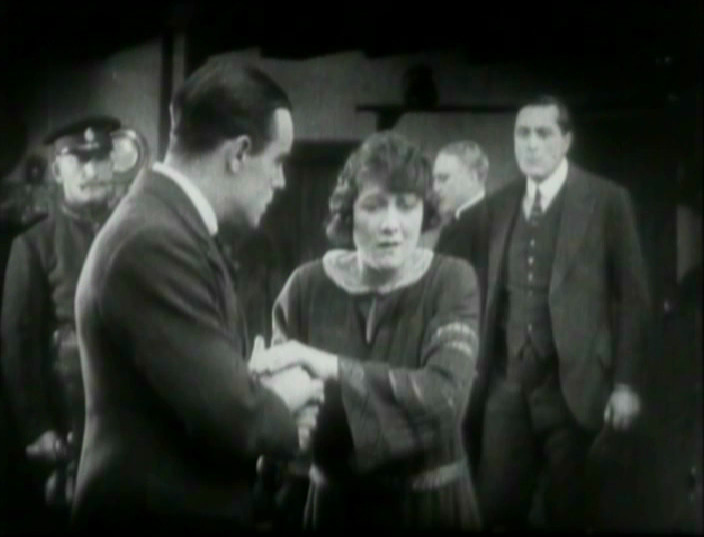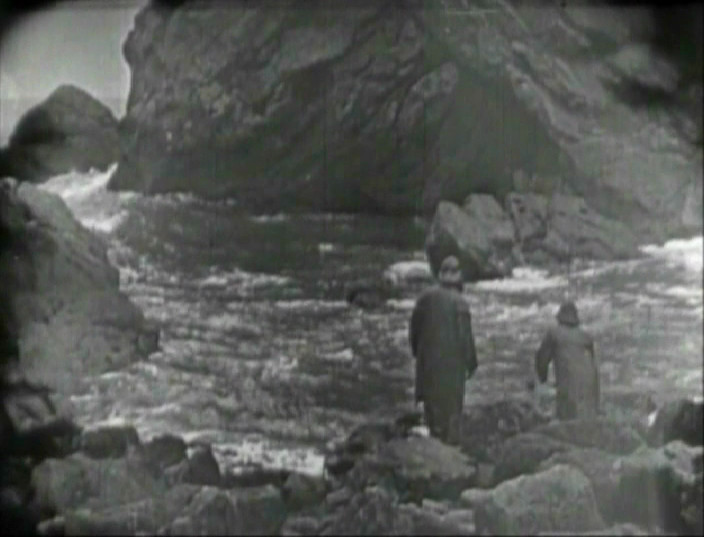Director: Cecil M. Hepworth
Writer: George Dewhurst, based on the novel by Dorin Craig
Stars: Alma Taylor, G. H. Mulcaster and James Carew
 |
There are a lot of things to say about Mist in the Valley, a feature directed by one of the true pioneers of film in the United Kingdom, Cecil M. Hepworth, for his own company, Hepworth Picture Plays, but the first has to be that it has little resemblance to the synopsis that’s stuck to it almost everywhere that it’s mentioned on the internet, including at IMDb.
Here’s what it says: “An ex-nun weds an amnesia victim and is framed for killing her usurping uncle who posed as her father.”
So let’s dissect that.
Margaret Yeoland is not an ex-nun. She’s a young lady who was brought up in a convent, which isn’t the same thing. She’s the happiest girl there, we’re told, but she’s leaving for her father’s estate in Devonshire because he wants her to come home. She’s looking forward to it but is disappointed when he turns out to be an alcoholic who aims to marry off this sheltered young thing to her elderly cousin. So she runs away from the home she’s only just found.
Denis Marlowe (with the ending E) is not an amnesiac. He’s someone who “backed a bill for a friend” which turned out to be a bad idea. He has lost all his money, his friendship and now his fiancée, because her father didn’t like him anyway and certainly won’t let her marry him now. He decides to commit suicide by hurling himself into the Thames but he’s talked out of it, grabs some sleep in a rail car and wakes up in Devonshire.
 |
Of course, they soon meet, Denis wandering the moors and Margaret sleeping there with a hope that nobody will find her. Whimsically, he calls her Heather Moreland, because she is unwilling to give her real name to a stranger.
They do marry, though, because it seems to be a good way for him to protect her, nice guy that he is. Initially, they plan to pretend to be married but the landlady who thinks they’re running away to be married introduces them to the new priest, who’s eager to wed his first couple and that’s that.
The man she believes to be her father does turn out to be her uncle, but she doesn’t know that until the final scenes and neither do we, unless we’d read this synopsis online. He’s also killed, but not because he’s her uncle. And, if I might be blunt, none of that matters, because this isn’t really a crime story, it’s a romantic drama and the murder is merely a MacGuffin hanging over the young couple like the Sword of Damocles, ready to spoil their peace.
Yes, she’s kinda sorta framed for the killing, but not really. She looks extremely suspicious because she ran away on the night that Squire Yeoland disappeared and, when his body turns up eventually, well, the suspicion doubles and, when she’s found, she’s tried for his murder.
However, that’s late in the film and prompts a shift in tone as it becomes a courtroom story with all the drama you might expect. She isn’t arrested until fifty minutes in and the feature only runs seventy-five. If it suddenly seems as if this film is spoiled, if that’s even possible a full century after its release, I’ll happily point out that it isn’t.
 |
There are plenty of reasons to watch Mist in the Valley a hundred years on, starting with a host of people involved.
Cecil M. Hepworth is the first, because he is a fascinating character. He was born to film, as his father showed magic lanterns, a precursor to the slide projector. Young Cecil took to the new technology, making his first film in 1897, the same year he wrote a book on filmmaking, the first such in the UK. After building a studio in 1899, he turned out three films a week and they included Alice in Wonderland, the first film based on Carroll’s book. He also invented the Vivaphone, which used phonographic records to add sound to films. Mist in the Valley was one of his last features, because he went bankrupt after Comin’ Thro’ the Rye later in 1923 and, the next year, his original negatives were melted down by the receivers for their silver content.
Alma Taylor is the next, because she was a bone fide star in 1923. She was only 28 but she had sixteen years behind her as a film actress, ever since 1907’s His Daughter’s Voice, and she looked good, even though she never used make-up on screen. The Daily News called her Britan’s top star in 1924 and she’d been voted that in 1915 by readers of Pictures and the Picturegoers, above a certain Charlie Chaplin.
She’s good here, overdoing it as silent actors tended to do but not so much that she takes us out of the moment. It helps that the film does keep on moving, not leaving us an opportunity to become bored, but she’s a very watchable leading lady. I’d like to see more of her work, but most of it was for Hepworth, who used a stock company, apparently realising the draw of studio stars very early indeed, including in Rescued by Rover in 1905 when he turned Blair, the family dog, into a household name and the world’s first canine film star.
 |
Other Hepworth regulars to appear include Gwynne Herbert as the landlady, Charles Vane as Squire Yeoland and John MacAndrews as a gloriously named servant, Job Pennyquick.
The male lead is G. H. Mulcaster, who can’t steal any scenes from Taylor but does a decent job regardless. Because this is 1923, society has him firmly in the dominant role and he acts accordingly, but we’re always watching Taylor when they’re both on screen. The best scenes Mulcaster gets are during bad communication between the two of them. Margaret is trying to let him know she’s pregnant but he believes that she’s trying to confess to the murder of her father. That’s a tough wake-up call!
What struck me more than the acting was the cinematography, which is stellar. I have no idea who to praise, but the composition is top notch, especially given that it’s on location. I felt nostalgic for the Devon moorland, where I spent a couple of summer holidays as a child.
It’s not just the framing of landscape shots, though, however good some of them are. This extends to scenes with people, especially late on in the courtroom when there are a massive number of actors sharing a small 4:3 screen.
The only negative aspect to me was that the intertitles were sparing and often vague. This film left me with a number of questions that I will have to go the source novel by Dorin Craig to answer. I could read between the lines but I wanted a little more detail. But hey, suddenly I’m a firm fan of rural Hepworth melodramas. If only more of them still existed.



No comments:
Post a Comment